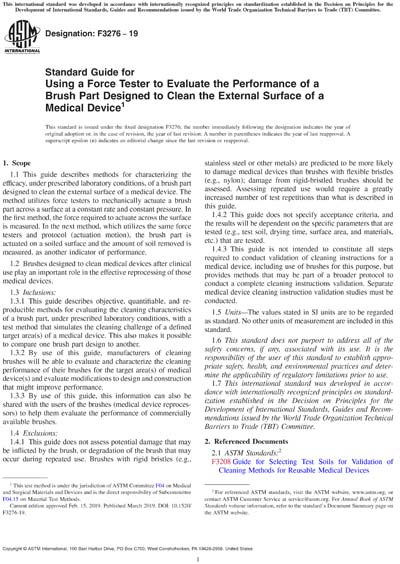Most recent
ASTM F3276-19
Standard Guide for Using a Force Tester to Evaluate the Performance of a Brush Part Designed to Clean the External Surface of a Medical Device
1.1 This guide describes methods for characterizing the efficacy, under prescribed laboratory conditions, of a brush part designed to clean the external surface of a medical device. The method utilizes force testers to mechanically actuate a brush part across a surface at a constant rate and constant pressure. In the first method, the force required to actuate across the surface is measured. In the next method, which utilizes the same force testers and protocol (actuation motion), the brush part is actuated on a soiled surface and the amount of soil removed is measured, as another indicator of performance.
1.2 Brushes designed to clean medical devices after clinical use play an important role in the effective reprocessing of those medical devices.
1.3 Inclusions:
1.3.1 This guide describes objective, quantifiable, and reproducible methods for evaluating the cleaning characteristics of a brush part, under prescribed laboratory conditions, with a test method that simulates the cleaning challenge of a defined target area(s) of a medical device. This also makes it possible to compare one brush part design to another.
1.3.2 By use of this guide, manufacturers of cleaning brushes will be able to evaluate and characterize the cleaning performance of their brushes for the target area(s) of medical device(s) and evaluate modifications to design and construction that might improve performance.
1.3.3 By use of this guide, this information can also be shared with the users of the brushes (medical device reprocessors) to help them evaluate the performance of commercially available brushes.
1.4 Exclusions:
1.4.1 This guide does not assess potential damage that may be inflicted by the brush, or degradation of the brush that may occur during repeated use. Brushes with rigid bristles (e.g., stainless steel or other metals) are predicted to be more likely to damage medical devices than brushes with flexible bristles (e.g., nylon); damage from rigid-bristled brushes should be assessed. Assessing repeated use would require a greatly increased number of test repetitions than what is described in this guide.
1.4.2 This guide does not specify acceptance criteria, and the results will be dependent on the specific parameters that are tested (e.g., test soil, drying time, surface area, and materials, etc.) that are tested.
1.4.3 This guide is not intended to constitute all steps required to conduct validation of cleaning instructions for a medical device, including use of brushes for this purpose, but provides methods that may be part of a broader protocol to conduct a complete cleaning instructions validation. Separate medical device cleaning instruction validation studies must be conducted.
1.5 Units—The values stated in SI units are to be regarded as standard. No other units of measurement are included in this standard.
1.6 This standard does not purport to address all of the safety concerns, if any, associated with its use. It is the responsibility of the user of this standard to establish appropriate safety, health, and environmental practices and determine the applicability of regulatory limitations prior to use.
1.7 This international standard was developed in accordance with internationally recognized principles on standardization established in the Decision on Principles for the Development of International Standards, Guides and Recommendations issued by the World Trade Organization Technical Barriers to Trade (TBT) Committee.
Content Provider
ASTM International [astm]






